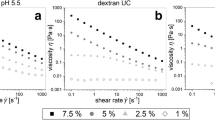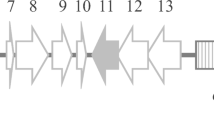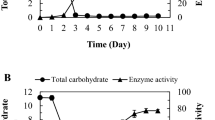Abstract
Dextran dextrinase (DDase) catalyzes formation of the polysaccharide dextran from maltodextrin. During the synthesis of dextran, DDase also generates the beneficial material isomaltomegalosaccharide (IMS). The term megalosaccharide is used for a saccharide having DP = 10–100 or 10–200 (DP, degree of polymerization). IMS is a chimeric glucosaccharide comprising α-(1 → 6)- and α-(1 → 4)-linked portions at the nonreducing and reducing ends, respectively, in which the α-(1 → 4)-glucosyl portion originates from maltodextrin of the substrate. In this study, IMS was produced by a practical approach using extracellular DDase (DDext) or cell surface DDase (DDsur) of Gluconobacter oxydans ATCC 11894. DDsur was the original form, so we prepared DDext via secretion from intact cells by incubating with 0.5% G6/G7 (maltohexaose/maltoheptaose); this was followed by generation of IMS from various concentrations of G6/G7 substrate at different temperatures for 96 h. However, IMS synthesis by DDext was limited by insufficient formation of α-(1 → 6)-glucosidic linkages, suggesting that DDase also catalyzes elongation of α-(1 → 4)-glucosyl chain. For production of IMS using DDsur, intact cells bearing DDsur were directly incubated with 20% G6/G7 at 45 °C by optimizing conditions such as cell concentration and agitation efficiency, which resulted in generation of IMS (average DP = 14.7) with 61% α-(1 → 6)-glucosyl content in 51% yield. Increases in substrate concentration and agitation efficiency were found to decrease dextran formation and increase IMS production, which improved the reaction conditions for DDext. Under modified conditions (20% G6/G7, agitation speed of 100 rpm at 45 °C), DDext produced IMS (average DP = 14.5) with 65% α-(1 → 6)-glucosyl content in a good yield of 87%.
Key points
• Beneficial IMS was produced using thermostabilized DDase.
• Optimum conditions for reduced dextran formation were successfully determined.
• A practical approach was established to provide IMS with a great yield of 87%.
Graphical abstract





Similar content being viewed by others
Data availability
The data that support the findings of this study are available from the corresponding authors on reasonable request.
References
Dubois M, Gilles AK, Hamilton KL, Rebers AP, Smith F (1959) Colorimetric method for determination of sugars and related substances. Anal Chem 28:350–356. https://doi.org/10.1021/ac60111a017
Hara H, Kume S, Iizuka T, Fujimoto Y, Kimura A (2017) Enzymatically synthesized megalo-type isomaltosaccharides enhance the barrier function of the tight junction in the intestinal epithelium. Biosci Biotechnol Biochem 82:629–635. https://doi.org/10.1080/09168451.2017.1398065
Hehre EJ (1951) The biological synthesis of dextran from dextrins. J Biol Chem 192:161–174. https://doi.org/10.1016/s0021-9258(18)55917-2
Iwaya H, Lee JS, Yamagishi S, Shinoki A, Lang W, Thawornkuno C, Kang HK, Kumagai Y, Suzuki S, Kitamura S, Hara H, Okuyama M, Mori H, Kimura A, Ishizuka S (2012) The delay in the development of experimental colitis from isomaltosyloligosaccharides in rats is dependent on the degree of polymerization. PLoS ONE 7:1–9. https://doi.org/10.1371/journal.pone.0050658
Lang W, Kumagai Y, Sadahiro J, Maneesan J, Okuyama M, Mori H, Sakairi N, Kimura A (2014) Different molecular complexity of linear-isomaltomegalosaccharides and β-cyclodextrin on enhancing solubility of azo dye ethyl red: towards dye biodegradation. Bioresour Technol 169:518–524. https://doi.org/10.1016/j.biortech.2014.07.025
Lang W, Sirisansaneeyakul S, Ngiwsara L, Mendes S, Martins LO, Okuyama M, Kimura A (2013) Characterization of a new oxygen-insensitive azoreductase from Brevibacillus laterosporus TISTR1911: toward dye decolorization using a packed-bed metal affinity reactor. Bioresour Technol 150:298–306. https://doi.org/10.1016/j.biortech.2013.09.124
Mountzouris KC, Gilmour SG, Jay AJ, Rastall RA (1999) A study of dextran production from maltodextrin by cell suspensions of Gluconobacter oxydans NCIB 4943. J Appl Microbiol 87:546–556. https://doi.org/10.1046/j.1365-2672.1999.00850.x
Saburi W, Mori H, Saito S, Okuyama M, Kimura A (2006) Structural elements in dextran glucosidase responsible for high specificity to long chain substrate. Biochim Biophys Acta 1764:688–698. https://doi.org/10.1016/j.bbapap.2006.01.012
Sadahiro J, Mori H, Saburi W, Okuyama M, Kimura A (2015) Extracellular and cell-associated forms of Gluconobacter oxydans dextran dextrinase change their localization depending on the cell growth. Biochem Biophys Res Commun 456:500–505. https://doi.org/10.1016/j.bbrc.2014.11.115
Shinoki A, Lang W, Thawornkuno C, Kang HK, Kumagai Y, Okuyama M, Mori H, Kimura A, Ishizuka S, Hara H (2013) A novel mechanism for the promotion of quercetin glycoside absorption by megalo α-1,6-glucosaccharide in the rat small intestine. Food Chem 136:293–296. https://doi.org/10.1016/j.foodchem.2012.08.028
Sundari CS, Raman B, Balasubramanian D (1991) Hydrophobic surfaces in oligosaccharides: linear dextrins are amphiphilic chains. Biochim Biophys Acta 1065:35–41. https://doi.org/10.1016/0005-2736(91)90007-u
Suzuki M, Unno T, Okada G (1999) Simple purification and characterization of an extracellular dextrin dextranase from Acetobacter capsulatum ATCC 11894. J Appl Glycosci 46:469–473. https://doi.org/10.5458/jag.46.469
Suzuki M, Unno T, Okada G (2000) A kinetic study of an extracellular dextrin dextranase from Acetobacter capsulatum ATCC 11894. J Appl Glycosci 47:27–33. https://doi.org/10.5458/jag.47.27
Suzuki M, Unno T, Okada G (2001) Functional characteristics of a bacterial dextrin dextranase from Acetobacter capsulatum ATCC 11894. J Appl Glycosci 48:143–151. https://doi.org/10.5458/jag.48.143
Thoma JA, Wright HB, French D (1959) Partition chromatography of homologous saccharides on cellulose columns. Arch Biochem Biophys 85:452–460. https://doi.org/10.1016/0003-9861(59)90510-7
Wang S, Mao X, Wang H, Lin J, Li F, Wei D (2011) Characterization of a novel dextran produced by Gluconobacter oxydans DSM 2003. Appl Microbiol Biotechnol 91:287–294. https://doi.org/10.1007/s00253-011-3267-6
Wichienchot S, Prasertsan P, Hongpattarakere T, Rastall RA (2009) Manufacture of gluco-oligosaccharide prebiotic by Gluconobacter oxydans NCIMB 4943. Songklanakarin J Sci Technol 31:597–603
Yamamoto K, Yoshikawa K, Kitahata S, Okada S (1992) Purification and some properties of dextrin dextranase from Acetobacter capsulatus ATCC 11894. Biosci Biotechnol Biochem 56:169–173. https://doi.org/10.1271/bbb.56.169
Yamamoto K, Yoshikawa K, Okada S (1993) Detailed action mechanism of dextrin dextranase from Acetobacter capsulatus ATCC 11894. Biosci Biotechnol Biochem 57:47–50. https://doi.org/10.1271/bbb.57.47
Yamamoto K, Yoshikawa K, Okada S (1993b) Effective dextran production from starch by dextrin dextranase with debranching enzyme. J Ferment Bioeng 76:411–413. https://doi.org/10.1016/0922-338X(93)90035-7
Acknowledgements
We would like to thank Nihon Shokuhin Kako (Tokyo, Japan) for kindly gifting us both products of Fujioligo G6 and G7 and Fujioligo G3.
Funding
This study was supported partially by a Program for Promotion of Basic and Applied Research for Innovations in Biooriented Industry (BRAIN, Japan; Grant No. 26062B) and the Japan Society for the Promotion of Science KAKENHI Grant Nos. 17H03801 and 19KK0147.
Author information
Authors and Affiliations
Contributions
WL and AK conceived and coordinated the study. WL, YK, JS, WS, and RS conducted experiments. WL, YK, JS, WS, RS, TT, MO, HM, NS, DK, and AK analyzed the data. WL and AK wrote the manuscript. All authors read and approved the final manuscript.
Corresponding authors
Ethics declarations
Ethics approval
This article does not involve any human subjects. The authors did not perform any animal-based experiments in this study.
Conflict of interest
The authors declare no competing interests.
Additional information
Publisher's note
Springer Nature remains neutral with regard to jurisdictional claims in published maps and institutional affiliations.
Rights and permissions
About this article
Cite this article
Lang, W., Kumagai, Y., Sadahiro, J. et al. A practical approach to producing isomaltomegalosaccharide using dextran dextrinase from Gluconobacter oxydans ATCC 11894. Appl Microbiol Biotechnol 106, 689–698 (2022). https://doi.org/10.1007/s00253-021-11753-6
Received:
Revised:
Accepted:
Published:
Issue Date:
DOI: https://doi.org/10.1007/s00253-021-11753-6




